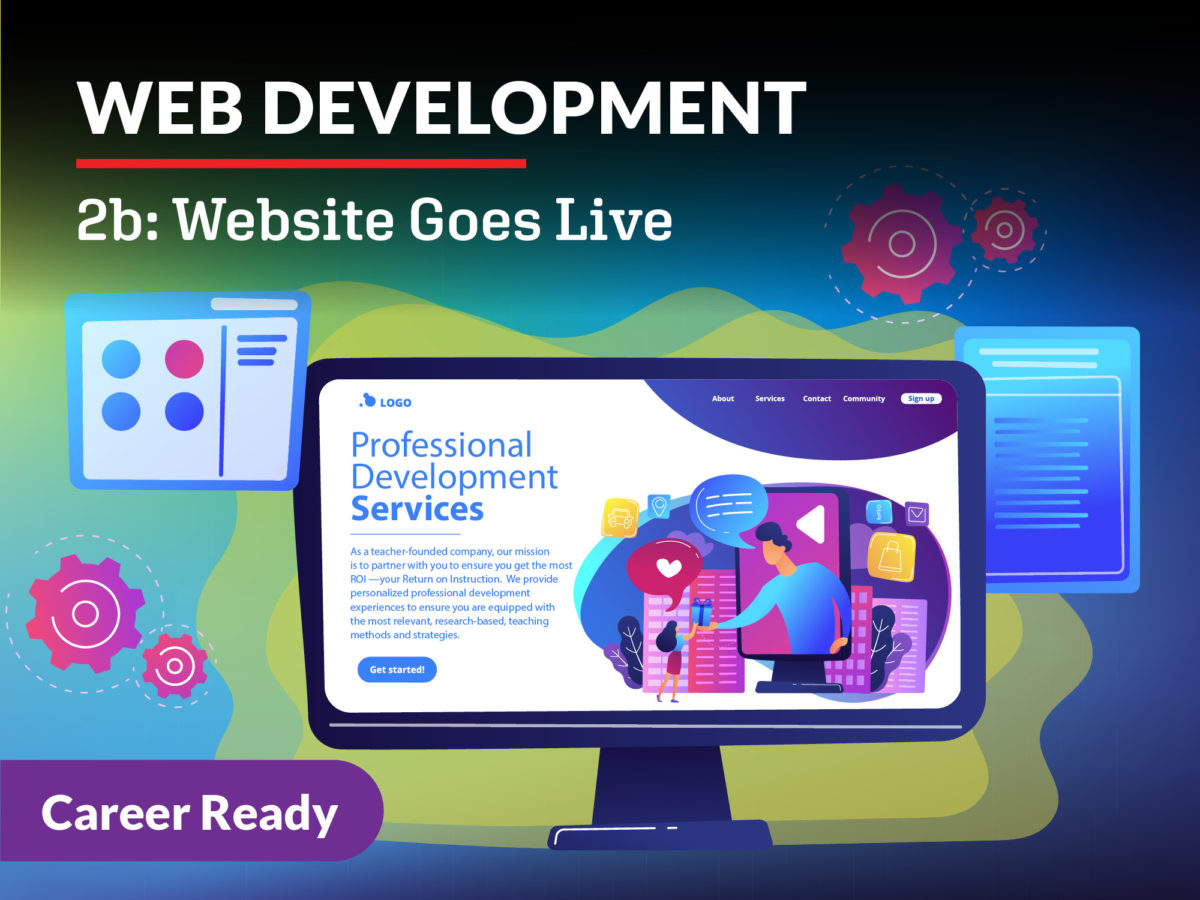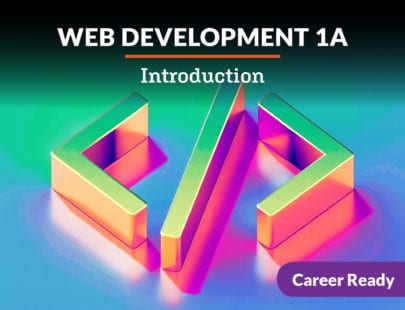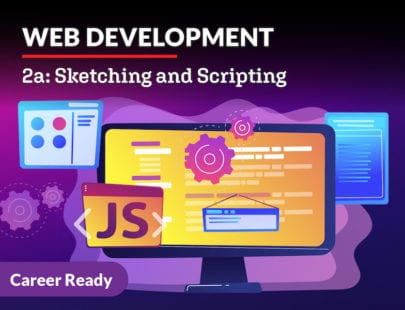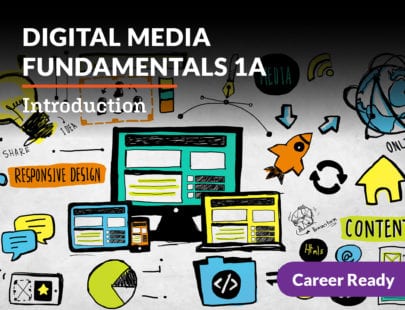
Web Development 2b: Website Goes Live
You’ve done a ton of work on your website already, and now, it’s time to put the finishing touches on it and make it work for you! In this course, you’ll explore topics and hone skills to help you perfect your portfolio so it’s ready to share with future employers. You’ll discover common coding errors and security threats, website accessibility and reliability, and become more fluent and efficient in JavaScript. You’ll also learn how to make on-the-job choices and adjustments and refine communication with your clients. In the end, you’ll turn your website into a presentation to share with friends and family so you can showcase your achievements.
Units at a Glance
Unit 1: Questing After Quality
Is your code doing what you expect it to? It’s easy to introduce errors into code as you write it. We’re only human, after all. You may be used to revising your essays and research papers and checking your presentation for errors, and you might be surprised by what you have found. Remember that computer code is also a language and needs to be checked to make sure it is doing exactly what you want it to be doing. Here you’ll learn some common JavaScript errors and ways to spot them.
What will you learn in this unit?
- Use modern developer tools to debug your code in an efficient and effective way
- Recognize, isolate, and correct common type and syntax errors in JavaScript
- Study and correct common runtime and logic errors in JavaScript
- Identify examples of reserved word usage and troubleshoot pre-built scripts and widgets incorporated into web pages
Unit 2: Secure Your Perimeter
Let’s pretend your website is your home: you likely want to control who gets access to which parts of the house. We’ll meet some historic cryptographers, the hackers of days gone by, whom you would have likely wanted as guests in your home. We’ll then take a look at the vulnerabilities of JavaScript and the common types of attacks that exploit those vulnerabilities. While we cover an overview of how to prevent such attacks, a lot of cybersecurity is best left in the hands of experts. Our main goal here is to make you aware of situations you may meet in your career. Just like you might check your windows and doors are locked before you go to bed, as a web developer, it’s important to know what tools you have at hand to prevent cyberattacks on your websites.
What will you learn in this unit?
- Describe how Native American Code Talkers and spoken code are precursors to modern cryptography
- Identify key figures and explain their contributions to the history of hacking
- Compare and contrast cross-site request forgery and cross-site scripting as the two main security threats related to JavaScript
- Explain procedures that can prevent CSRF or XSS attacks
- Locate your role in the cybersecurity industry and identify what opportunities you have to increase your cybersecurity experience
Unit 3: Evaluate the Product
What are the steps between having a working form of your product and releasing it live for your customers to use? A whole lot of testing. Your main goal is to have a product that does what the client expects it to and works for as many users as possible. Within this framework, there are a number of accessibility options and various methods of testing and getting feedback on your product before you go live. Better to get the feedback early before it affects your product ratings!
What will you learn in this unit?
- Give examples of structural accessibility features that would help a screen reader navigate a website
- Identify accessibility features related to forms and links, and summarize why having sufficient text contrast is an accessibility concern
- Explain when and when not to automate display and functionality testing
- Develop an evaluation method to analyze the effect of the product or service on client satisfaction
- Set up a product trial or product demonstration
Unit 4: Prepare for Launch
As you prepare a project for launch there are many things to consider: How will you work out the details with your client? Is the project a one-time contract or an ongoing relationship? How will you market your work or the product the client is selling? Is the project sustainable? What do you need to do to plan for the future while you launch the initial release?
What will you learn in this unit?
- Identify and demonstrate professional communication with clients
- Explain what a retainer is and give examples of web development tasks that are best suited to be catered for in a retainer
- Highlight the key components of a web development retainer
- Discuss the various options available in internet marketing
- Develop a sustainability plan for the product or service
Unit 5: Introduction to Data Structures
Websites are no longer used just to display content with nice colors and fonts. Nowadays, a web developer needs to be able to handle data, whether that’s for visualizations, gaming, or e-commerce. And in order to handle data, a web developer needs to know how to structure data and write algorithms that collect, analyze, and transform that data. Part of a web developer’s job is to carefully consider the right data structure for the task at hand. So let’s dig deeper into data!
What will you learn in this unit?
- Declare an array in JavaScript and access needed data from an array
- Explain which array method would best suit given use cases
- Write loops and methods using JavaScript arrays, including sorting
- Explain how functions work in JavaScript
- Pass functions as variables into other functions
- Describe how to modify an object’s properties, based on a given use case
Unit 6: Code Complexity
When we are developing software, we have to know how to write our code so that it runs fast and stores data in memory in smart ways. There are many ways to write algorithms and many types of data structures. Choosing the right ones for your projects can be tricky. Knowing the trade-offs will help you use the right tool for the job. Learning to write more efficient code will help you get better jobs, spend less time debugging and rewriting your code, and create software that runs faster with the same hardware.
What will you learn in this unit?
- Explain why it’s important to measure code complexity
- Describe the Big O complexity of constant, linear, quadratic, and polynomial time algorithms and explain what these algorithms are used for
- Describe the Big O complexity of logarithmic, linearithmic, exponential, and factorial time algorithms, and explain what these algorithms are used for
- Identify various data types and structures and describe how they contribute to code complexity
- Explain how to perform breadth-first and depth-first searches and their applications
- Apply searching and sorting to Dijkstra’s algorithm and the traveling salesperson problem
Unit 7: Software Testing
Testing your code is one of the most important parts of being a successful web developer. Without testing, you won’t know if your programs actually work until customers complain to you about problems. When you hear about problems, how will you know how to fix them? Software testing gives you the skills you need to find issues in your work before you release your code into the wild and helps you create better quality, safer, and more reliable final products.
What will you learn in this unit?
- Explain the general principles of unit testing
- Identify the key characteristics of test-driven development (TDD)
- Compare integration testing with unit testing
- Summarize the principles and methods of end-to-end testing
Unit 8: Continuing the Cycle
Once you’ve spent all this time creating a great website, you’ll want that website to keep on working! And so do your clients and users. Reliable design is an important consideration as you polish up a website and prepare to set it loose on the web. Have you given your website room to grow? Is it set up to be responsive to the wide variety of mobile devices that may be used to access it? We’ll look at all of these topics and get you ready to present your portfolio in a professional setting.
What will you learn in this unit?
- Explain what reliability means when used to describe website design
- Implement various methods of responsive web design using HTML and CSS
- Describe how verbal, nonverbal, written, and visual communication skills can be used to one’s advantage in a professional setting
- Use the structure of a portfolio presentation to share your work professionally
- Prepare for an interview by knowing the steps and expectations involved







